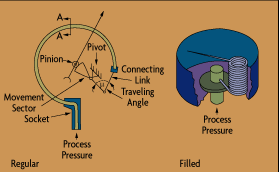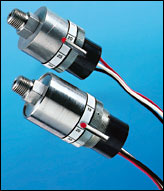Pressure gauges and switches are among the most often used instruments in a plant. But because of their great numbers, attention to maintenance--and reliability--can be compromised. As a consequence, it is not uncommon in older plants to see many gauges and switches out of service. This is unfortunate because, if a plant is operated with a failed pressure switch, the safety of the plant may be compromised. Conversely, if a plant can operate safely while a gauge is defective, it shows that the gauge was not needed in the first place. Therefore, one goal of good process instrumentation design is to install fewer but more useful and more reliable pressure gauges and switches.
 |
| Figure 5-1: Pressure Gauge Designs |
One way to reduce the number of gauges in a plant is to stop installing them on the basis of habit (such as placing a pressure gauge on the discharge of every pump). Instead, review the need for each device individually. During the review one should ask: "What will I do with the reading of this gauge?" and install one only if there is a logical answer to the question. If a gauge only indicates that a pump is running, it is not needed, since one can hear and see that. If the gauge indicates the pressure (or pressure drop) in the process, that information is valuable only if one can do something about it (like cleaning a filter); otherwise it is useless. If one approaches the specification of pressure gauges with this mentality, the number of gauges used will be reduced. If a plant uses fewer, better gauges, reliability will increase.
 |
| Pressure switches with adjustable setpoints. |